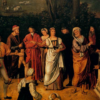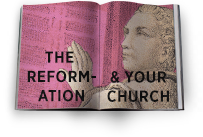The Reformation’s Restoration of the Sacraments
The Protestant Reformation of the sixteenth century restored the gospel to the sacraments and the sacraments to the congregation.
Why did the sacraments need restoring? Penance, purgatory, indulgences, the cult of the saints—these all added up to a system in which the sacraments enabled individuals to chip away at the hopelessly massive debt of their own or others’ sins. And the late medieval mass was fundamentally something the laity watched, not a meal they ate.
Along with recovering the biblical gospel, the Reformers recovered a doctrine and practice of the sacraments that flow from and fit with the gospel. Because Christ has paid the entire debt of our sins, the sacraments picture and promise complete forgiveness; and because the gospel gathers God’s people into a local body, the sacraments embody and enact the congregation’s unity in Christ.
In what follows I will briefly illustrate this twofold restoration from the writings and practice of three key Reformers: Luther, Calvin, and Cranmer. I will give more attention to the Lord’s Supper than to baptism, for two reasons. First, in some respects the contrast between the Protestant Lord’s Supper and the Roman Catholic mass is more striking and pronounced than the contrast between their practices of (usually) infant baptism. Second, as a Baptist, I think baptism is a key place where the magisterial Reformers did not go far enough. In the interest of objectivity, however, I’ll table my disagreement and show how, even in the practice of infant baptism, the Reformers intended to restore the gospel’s primacy and the congregation’s participation.
LUTHER
Consider first how Luther restored the gospel to the Lord’s Supper (which he still calls “the mass,” though radically redefining the term). In The Babylonian Captivity of the Church (1520), he wrote,
According to its substance, therefore, the mass is nothing but the aforesaid words of Christ: “Take and eat, etc” [Matt 26:26], as if he were saying: “Behold, O sinful and condemned man, out of the pure and unmerited love with which I love you, and by the will of the Father of mercies [II Cor. 1:3], apart from any merit or desire of yours, I promise you in these words the forgiveness of all your sins and life everlasting. And that you may be absolutely certain of this irrevocable promise of mine, I shall give my body and pour out my blood, confirming this promise by my very death, and leaving you my body and blood as a sign and memorial of this same promise. As often as you partake of them, remember me, proclaim and praise my love and bounty toward you, and give thanks.[1]
Because the Lord’s Supper is nothing but Christ’s promise held out to us, what it requires of its recipients is faith:
From this you will see that nothing else is needed for a worthy holding of the mass than a faith that relies confidently on this promise, believes Christ to be true in these words of his, and does not doubt that these infinite blessings have been bestowed upon it. . . . Who would not shed tears of gladness, indeed, almost faint for joy in Christ, if he believed with unshaken faith that this inestimable promise of Christ belonged to him?[2]
In his 1519 Sermon on the Blessed Sacrament of the Holy, True Body of Christ Luther argues that the congregation should receive both elements. Why? Because distributing only one fails to indicate the “complete union and undivided fellowship of the saints.”[3] Luther argues, “Thus in the sacrament we too become united with Christ, and are made one body with all the saints, so that Christ cares for us and acts on our behalf.”[4] For Luther, our communion with Christ in the “sweet exchange” of the gospel creates a congregational communion: “Through the interchange of his blessings and our misfortunes, we become one loaf, one body, one drink, and have all things in common.”[5]
CALVIN
Here now is Calvin on the relation between the gospel and the Lord’s Supper. The point will be proved long before the end of the excerpt, so take the rest as medicine for your soul:
Godly souls can gather great assurance and delight from this Sacrament; in it they have a witness of our growth into one body with Christ such that whatever is his may be called ours. As a consequence, we may dare assure ourselves that eternal life, of which he is the heir, is ours; and that the Kingdom of Heaven, into which he has already entered, can no more be cut off from us than from him; again, that we cannot be condemned for our sins, from whose guilt he has absolved us, since he willed to take them upon himself as if they were his own. This is the wonderful exchange which, out of his measureless benevolence, he has made with us; that, becoming Son of man with us, he has made us sons of God with him; that, by his descent to earth, he has prepared an ascent to heaven for us; that, by taking on our mortality, he has conferred his immortality upon us; that, accepting our weakness, he has strengthened us by his power; that, receiving our poverty unto himself, he has transferred his wealth to us; that, taking the weight of our iniquity upon himself (which oppressed us), he has clothed us with his righteousness.[6]
As to the Supper’s role in embodying the whole congregation’s communion with Christ and each other, Calvin connects the two in his comments on 1 Corinthians 10:16–17, “For we must first of all be incorporated (so to speak) into Christ, that we may be united to each other.”[7] And again in his Institutes: “Now, since he has only one body, of which he makes us all partakers, it is necessary that all of us also be made one body by such participation. The bread shown in the Sacrament represents this unity.”[8]
What is the practical, pastoral effect of this twofold restoration? If the Lord’s Supper confirms our communion with Christ and with each other, how should we live together?
We shall benefit very much from the Sacrament if this thought is impressed and engraved upon our minds: that none of the brethren can be injured, despised, rejected, abused, or in any way offended by us, without at the same time, injuring, despising, and abusing Christ by the wrongs we do; that we cannot disagree with our brethren without at this same time disagreeing with Christ; that we cannot love Christ without loving him in the brethren; that we ought to take the same care of our brethren’s bodies as we take of our own; for they are members of our body; and that, as no part of our body is touched by any feeling of pain which is not spread among all the rest, so we ought not to allow a brother to be affected by any evil, without being touched with compassion for him.[9]
CRANMER
What about Thomas Cranmer, chief liturgical architect of the English Reformation? For Cranmer, both sacraments tangibly present the gospel to the congregation. In both baptism and the Lord’s Supper we not only hear the gospel, but see and touch and feel and taste it:
So that the washing in water of baptism is, as it were, shewing of Christ before our eyes, and a sensible touching, feeling, and groping of him, to the confirmation of the inward faith, which we have in him. . . . And for this cause Christ ordained this sacrament in bread and wine (which we eat and drink, and be chief nutriments of our body), to the intent that as surely as we see the bread and wine with our eyes, smell them with our noses, touch them with our hands, and taste them with our mouths, so assuredly ought we to believe that Christ is a spiritual life and sustenance of our souls . . . Thus our Saviour Christ . . . hath ordained sensible signs and tokens whereby to allure and to draw us to more strength and more constant faith in him.[10]
For Cranmer, it is precisely because the sacraments physically portray and present the gospel that they nourish faith. Further, for Cranmer, similar to Luther and Calvin, the common loaf and cup of the Supper signify our spiritual union not only with Christ but with each other: “[T]he bread and wine do most lively represent unto us the spiritual union and knot of all faithful people, as well unto Christ, as also among themselves.”[11]
Finally, a word about infant baptism, taking Cranmer as our exemplar. While I detect here certain inconsistencies, it is worth pointing out that Cranmer’s confession and liturgy rightly highlight baptism’s corporate, congregational dimensions. Here, for instance, is part of Article 29, the Thirty Nine Articles’ statement on baptism: “Baptism is not only a sign of profession, and mark of difference, whereby Christian men are discerned from others that be not christened, but it is also a sign of Regeneration or New-Birth, whereby, as by an instrument, they that receive Baptism rightly are grafted into the Church.”[12] And again, per the Book of Common Prayer (1552), following the “baptism” the minister is to pray, “We receive this child into the congregation of Christ’s flock.”[13] While I think there is something wrong here, there is certainly something right. Baptism is not a private ordinance, but the front door into the local congregation, a “mark of difference” between the church and the world.
TODAY?
While we might not state it so baldly, we modern evangelicals are tempted to treat the Reformation as the triumph of the gospel over the sacraments. The Roman Catholic Church had lost the gospel in its wrongful adoration (literally) of the sacraments, and so the Reformers regained the gospel by sidelining the sacraments. Well, not quite.
For the Reformers, Word and sacrament are not enemies but the best of friends. The Word is powerful and primary. And yet Christ has wisely and kindly joined two sacraments to that Word, both to nourish our faith and to mark off his people from the world. We rightly celebrate the Reformation’s recovery of justification by faith alone. But the gospel the Reformation recovered gives birth to a gospel people who form a gospel polity. So let us also learn from the Reformers’ insights into the signs of the gospel that bind together the people of the gospel.
[1] Martin Luther, “The Babylonian Captivity of the Church,” in Three Treatises (Minneapolis: Fortress, 1970), 158.
[2] Ibid.
[3] The phrasing is that of Dean Zweck, “The Communion of Saints in Luther’s 1519 Sermon, The Blessed Sacrament of the Holy and True Body,” LTJ 49 (2015): 118, summarizing Luther.
[4] LW 35:58; cited in Zweck, “The Communion of the Saints,” 119.
[5] Ibid.
[6] John Calvin, Institutes of the Christian Religion, ed. John T. McNeill, trans. Ford Lewis Battles, vol. 2, The Library of Christian Classics (Louisville, KY: Westminster John Knox, 1960), 1361–62 (4.17.2).
[7] John Calvin, Commentary on the Epistles of Paul the Apostle to the Corinthians, trans. John Pringle, Calvin’s Commentaries 20 (Grand Rapids: Baker, 2009), 335.
[8] Calvin, Institutes, 2:1415 (4.17.38).
[9] Ibid.
[10] John Edmund Cox, ed., Writings and Disputations of Thomas Cranmer Relative to the Lord’s Supper (Cambridge: The University Press, 1844), 41; cited in Ashley Null, “Thomas Cranmer,” in Christian Theologies of the Sacraments: A Comparative Introduction, ed. Justin S. Holcomb and David A. Johnson (New York: New York University Press, 2017), 220.
[11] In An Answer to a crafty and sophistical cavilliation devised by Stephen Gardiner (1551); spelling modernized. I owe this citation, and the following points on Cranmer’s theology of baptism, to my friend Stephen Tong’s excellent essay for the 2016 Lightfoot Scholarship at Cambridge, “The Sacraments as Practical Ecclesiology in the Church of Edward VI, 1547–1553,” 29. Cheers, mate!
[12] Accessed at: http://anglicansonline.org/basics/thirty-nine_articles.html.
[13] Available at: http://justus.anglican.org/resources/bcp/1552/Baptism_1552.htm; spelling modernized.









